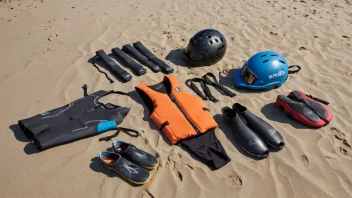What are the essential safety measures for water sports?
When engaging in water sports, it's crucial to prioritize safety. Essential measures include wearing appropriate life jackets, conducting regular safety drills, and ensuring constant adult supervision. Check that the equipment is suitable for children's sizes and skill levels.
How can I teach my child about water safety?
Start by teaching children basic swimming skills and safe behaviors around water. Discuss the importance of never swimming alone and the need to be aware of their surroundings. Use educational materials like videos or books about water safety to reinforce these lessons.
What should I look for in a life jacket for my child?
When selecting a life jacket, ensure it is U.S. Coast Guard-approved and appropriate for your child's weight and size. Look for a snug fit that allows for movement but prevents slipping off. Additionally, consider jackets with bright colors and reflective strips for better visibility.
Are there specific water sports that are safer for children?
Some water sports are generally considered safer for children, such as kayaking, paddleboarding, or snorkeling in shallow waters. Always assess the conditions and provide proper supervision and guidance. Avoid activities like water skiing or surfing until they are older and more experienced.
How can I ensure my child's equipment is safe?
Regularly inspect all water sports equipment for wear and tear. Ensure that any inflatable devices are fully inflated and check for leaks. For non-inflatable items, examine for cracks or damage. It's also essential to make sure all equipment is age-appropriate and meets safety standards.
What role does supervision play in water safety?
Supervision is one of the most critical factors in ensuring a safe water sports environment. An adult should always be present and vigilant, keeping a close eye on children in and around the water. Designate a 'water watcher' to maintain focus exclusively on supervising kids while they are engaging in water activities.
How can I prepare for emergency situations while water sports?
Preparation for emergencies includes having a first aid kit readily available, knowing CPR, and being familiar with the signs of drowning. Teach your child how to signal for help and ensure that everyone involved knows the emergency procedures for the location you are at.
What is the importance of weather conditions in planning water sports?
Weather conditions significantly affect safety during water sports. Always check the local weather forecast before heading out. Avoid water sports during storms, high winds, or extreme temperatures. Understanding water conditions can help in making informed decisions about when and where to engage in activities.
How can I make water sports fun and safe for my child?
Incorporate games, challenges, and friendly competitions that emphasize teamwork and safety. Use colorful and fun equipment to keep your child engaged. Always encourage them to communicate their feelings about their experiences, ensuring they feel comfortable and secure in the water.
In conclusion, creating a safe water sports environment for children involves a combination of proper preparation, supervision, and education. By following these guidelines, you can ensure that your child enjoys water sports safely and confidently.






